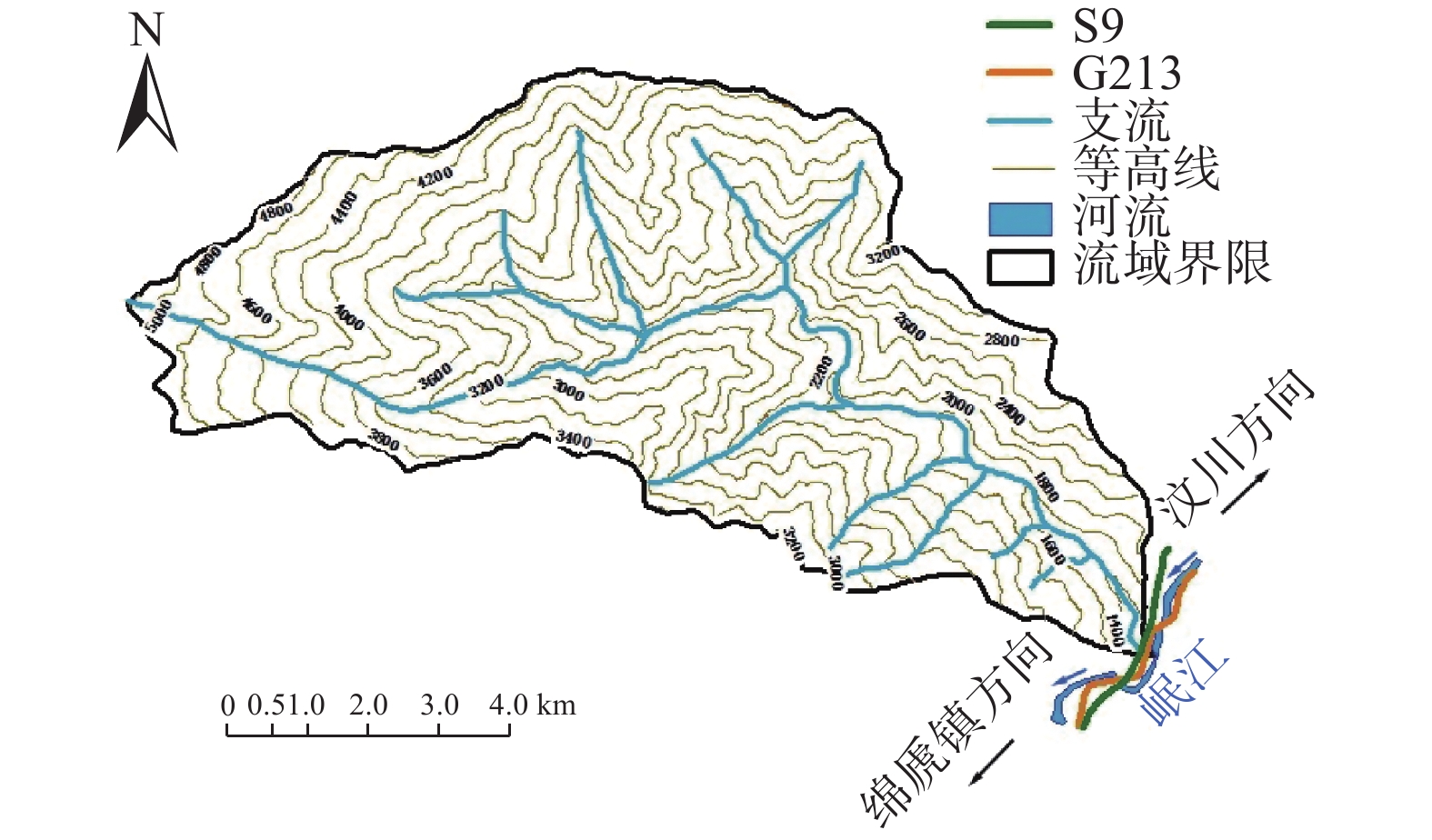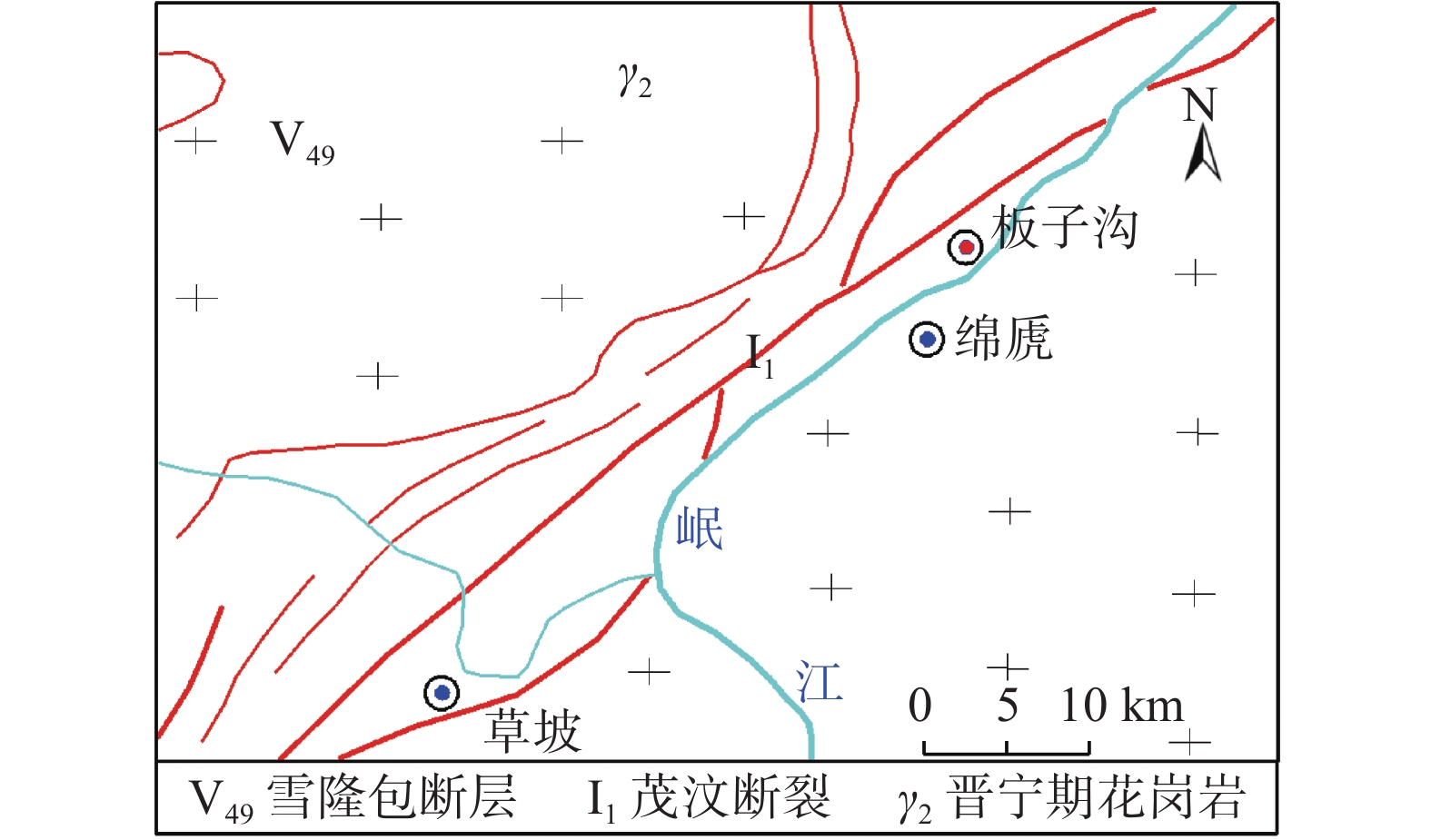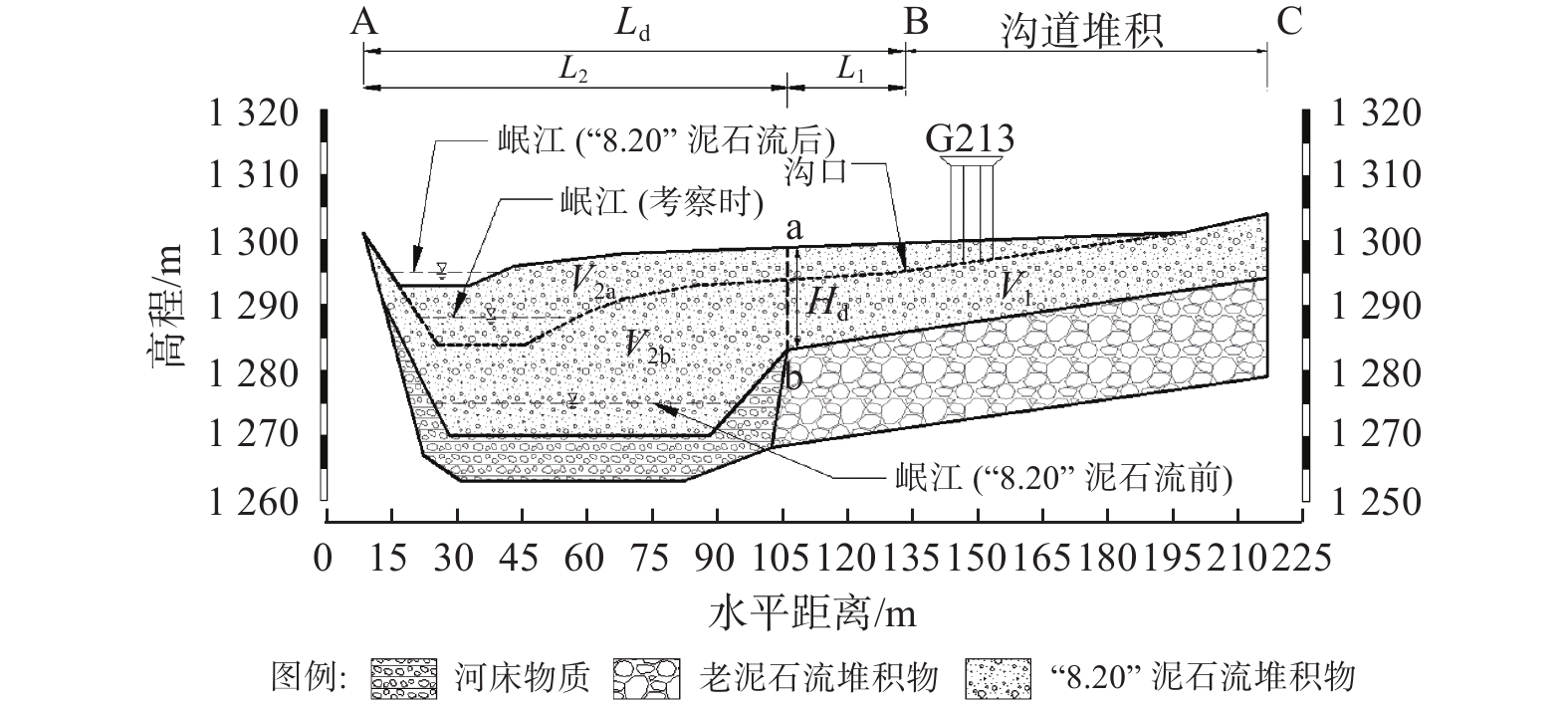The river blockage characteristics of “8·20” large-scale debris flow and the hazard prediction in Banzi gully in Miansi Town,Wenchuan County
-
摘要:
汶川地震后,板子沟曾发生过多次大规模泥石流,尤其是2019年“8·20”泥石流对沟口的道路桥梁以及村寨造成了严重的破坏,将主河道向对岸严重挤压,今后仍存在较大堵河的风险。文章在野外调查以及对泥石流基本特征和形成条件综合分析的基础上,分析了堵河特征,计算了不同频率下泥石流的堵河参数,并预测了各频率下溃决洪水对绵虒镇可能产生的影响。计算结果表明,频率为2%、5%和10%的泥石流造成岷江堵塞的可能性较小,假设发生堵河事件,绵虒镇也不会受到溃坝洪水的危害。频率为1%的泥石流很可能造成主河堵塞。体积约57.38×104 m3的泥石流物质可以到达岷江,形成高度约为51.61 m的堰塞坝。在主河洪水的作用下,堰塞坝发生溃坝,溃坝洪水的峰值流量为5 935.49 m3/s,到达绵虒镇后降至2 312.25 m3/s。由于相应的洪水深度(4.00 m)大于防护堤的高度(3.50 m),因此溃坝洪水很可能会对绵虒镇防护堤附近民房造成破坏。为今后大型泥石流堵河特征的分析,以及溃决洪水对下游城镇可能造成的影响提供了参考。
Abstract:After Wenchuan earthquake, many large debris flow have occur in Banzi Gully. Especially in 2019, the "8·20" debris flow caused serious damage to the roads, bridges and villages in the gully mouth, mail river was seriously squeeaed to the other side and there is a big risk of blocking the river in the future. Based on the field investigation and comprehensive analysis of the basic characteristics and formation conditions of the debris flow, the characteristics of river blockage are analyzed, the parameters of river blockage under different debris flow frequency are calculated, and the possible impact of dam-breaking flood under each frequency on Miansi Town is predicted. The results show that debris flow with frequencies of 2%, 5% and 10% are less likely to cause river blockage of Min River, and if there was a river blocking event , the town of Miansi would not be exposed to dam-breaking flood. The debris flow with a frequency of 1% are likely to cause river blockage. The debris flow material with a volume of 57.38×104 m3 can reach the Min River to form a dam with a height of about 51.61 m. Under the action of the main river flood (1890.0 m3/s), the dam will be broken, and the peak flow rate of the flood was 5935.49 m3/s, which dropped to 2312.25 m3/s while arrive at Miansi Town. Since the flood depth (4.00 m) is higher than the height of the protective embankment (3.5 m), the flood is likely to damage the houses near the protective embankment of Miansi Town.This paper provided a reference for the analysis of the characteristics of large-scale debris flow blockage in the future, as well as the possible impact of the collapse flood on downstream towns.
-
Key words:
- Banzi gully /
- debris flow /
- river blocking /
- dam-breaking flood /
- hazard prediction
-

-
表 1 板子沟泥石流基本运动参数计算结果
Table 1. Calculation results of the basic motion parameters of debris flow in Banzi gully
计算内容 参数 单位 频率 1% 2% 5% 10% 容重计算 
t·m−3 1.70 1.62 1.50 1.42 流速计算 
/ 12.50 12.50 12.50 12.50 
/ 0.74 0.59 0.44 0.34 
t·m−3 2.60 2.60 2.60 2.60 
m 6.10 4.05 2.02 1.32 
/ 0.23 0.23 0.23 0.23 
m·s−1 10.64 8.70 5.95 4.78 洪峰流量计算 
mm·h−1 38.54 35.02 30.10 26.4 
/ 0.93 0.93 0.93 0.93 
/ 0.88 0.87 0.85 0.84 
/ 2.79 2.63 2.39 2.20 
h 2.75 2.84 2.98 3.11 
m3·s−1 197.32 173.81 143.22 119.76 泥石流流量计算 
/ 3.00 2.80 2.60 2.40 
m3·s−1 1028.15 776.17 535.98 385.27 一次冲出总量计算 
s 3600 3600 3600 3600 
104 m3 97.72 73.77 50.94 36.62 表 2 形态调查法泥石流流量计算结果
Table 2. Results of flow calculation by morphological investigation method of debris flow in Banzi gully
断面
位置断面高程
/m沟道宽度
/m平均泥深
/m过流面积
/m2平均流速
/(m·s−1)峰值流量
/(m3·s−1)断面1 1255 71 2.1 149.1 4.74 707.39 断面2 1263 70 2 140 4.77 667.49 表 3 不同频率下泥石流堵河参数计算结果
Table 3. The calculation results of river blockage parameters at different frequencies
P/% 
/(t·m−3)
/(m3·s−1)
/(m·s−1)
/(m3·s−1)
/(m·s−1)
1 1.70 1028.15 11.70 1890 5.40 2.00 2 1.62 776.17 9.57 1890 5.40 1.18 5 1.50 535.98 6.54 1890 5.40 0.52 10 1.42 385.27 5.26 1890 5.40 0.28 表 4 其他堵河公式计算结果
Table 4. The calculation results of the river blockage parameters at different frequencies
表 5 不同频率下泥石流堵河高度计算结果
Table 5. The calculation results of the height of river blockage at different frequencies
P/% 
/m3
/m
/m
/m
/m3
/m3
/m1 97.72 18.20 243.47 273.04 40.33 57.38 51.61 2 73.77 16.95 221.76 248.65 31.15 42.61 44.48 5 50.94 15.47 196.10 219.81 22.23 28.71 36.51 10 36.62 14.30 175.74 196.94 16.49 20.12 30.56 表 6 不同频率下堰塞坝溃坝洪水计算结果
Table 6. The calculation results of dam-breaking flood with different frequencies
P/% 
/m
/(m3·s−1)
/(m3·s−1) /m3
/m3
/104m3
/(m·s−1)
/m1 51.61 5935.49 2312.25 285.26 3.64 7.24 4.00 2 44.48 4760.71 1704.09 199.88 3.06 6.45 3.31 5 36.51 3555.03 1108.91 121.37 2.39 5.47 2.54 10 30.56 2735.38 725.68 74.38 1.86 4.64 1.96 -
[1] 谢洪, 钟敦伦, 矫震, 等. 2008年汶川地震重灾区的泥石流[J]. 山地学报,2009,27(4):501 − 509. [XIE Hong, ZHONG Dunlun, JIAO Zhen, et al. Debris flow in Wenchuan quake-hit area in 2008[J]. Journal of Mountain Science,2009,27(4):501 − 509. (in Chinese with English abstract) doi: 10.3969/j.issn.1008-2786.2009.04.017
[2] 庄建琦, 崔鹏, 葛永刚, 等. “5·12”地震后都汶公路沿线泥石流沟危险性评价[J]. 四川大学学报(工程科学版),2009,41(3):131 − 139. [ZHUANG Jianqi, CUI Peng, GE Yonggang, et al. Hazard assessment of debris flow valleys along Dujiangyan-Wenchuan highway after “5·12” Wenchuan devastating earthquake[J]. Journal of Sichuan University (Engineering Science Edition),2009,41(3):131 − 139. (in Chinese with English abstract)
[3] CUI P, HU K H, ZHUANG J Q, et al. Prediction of debris-flow danger area by combining hydrological and inundation simulation methods[J]. Journal of Mountain Science,2011,8(1):1 − 9. doi: 10.1007/s11629-011-2040-8
[4] 余斌, 谢洪, 王士革, 等. 汶川县泥石流沟在汶川“5·12”地震后的活动趋势[J]. 自然灾害学报,2011,20(6):68 − 73. [YU Bin, XIE Hong, WANG Shige, et al. Activity tendency of debris flow gully in Wenchuan County after “5·12” Wenchuan earthquake[J]. Journal of Natural Disasters,2011,20(6):68 − 73. (in Chinese with English abstract)
[5] 周荣军, 蒲晓虹, 何玉林, 等. 四川岷江断裂带北段的新活动、岷山断块的隆起及其与地震活动的关系[J]. 地震地质,2000,22(3):285 − 294. [ZHOU Rongjun, PU Xiaohong, HE Yulin, et al. Recent activity of Minjiang fault zone, uplift of Minshan block and their relationship with seismicity of Sichuan[J]. Seismology and Geology,2000,22(3):285 − 294. (in Chinese with English abstract) doi: 10.3969/j.issn.0253-4967.2000.03.009
[6] 杨成林, 陈宁生, 李战鲁. 汶川地震次生泥石流形成模式与机理[J]. 自然灾害学报,2011,20(3):31 − 37. [YANG Chenglin, CHEN Ningsheng, LI Zhanlu. Formation mode and mechanism fordebris flow induced by Wenchuan earthquake[J]. Journal of Natural Disasters,2011,20(3):31 − 37. (in Chinese with English abstract)
[7] 张会平, 杨农, 张岳桥, 等. 岷江水系流域地貌特征及其构造指示意义[J]. 第四纪研究,2006,26(1):126 − 135. [ZHANG Huiping, YANG Nong, ZHANG Yueqiao, et al. Geomorphology of the Minjiang drainage system (Sichuan, China) and its structural implications[J]. Quaternary Sciences,2006,26(1):126 − 135. (in Chinese with English abstract) doi: 10.3321/j.issn:1001-7410.2006.01.016
[8] 谭万沛. 中国暴雨泥石流预报研究基本理论与现状[J]. 土壤侵蚀与水土保持学报,1996,10(1):88 − 95. [TAN Wanpei. Basic theory and study situation of rainstorm debris flow forecastin China[J]. Journal of Soil Erosion and Soil Conservation,1996,10(1):88 − 95. (in Chinese with English abstract)
[9] TANG C, ZHU J, LI W L, et al. Rainfall-triggered debris flows following the Wenchuan earthquake[J]. Bulletin of Engineering Geology and the Environment,2009,68(2):187 − 194. doi: 10.1007/s10064-009-0201-6
[10] 唐川, 梁京涛. 汶川震区北川9·24暴雨泥石流特征研究[J]. 工程地质学报,2008,16(6):751 − 758. [TANG Chuan, LIANG Jingtao. Characteristics of debris flows in Beichuan epicenter of the Wenchuan earthquake triggered by rainstorm on September 24, 2008[J]. Journal of Engineering Geology,2008,16(6):751 − 758. (in Chinese with English abstract) doi: 10.3969/j.issn.1004-9665.2008.06.004
[11] 倪化勇, 郑万模, 唐业旗, 等. 绵竹清平8·13群发泥石流成因、特征与发展趋势[J]. 水文地质工程地质,2011,38(3):129 − 133. [NI Huayong, ZHENG Wanmo, TANG Yeqi, et al. Formation, characteristics and trend of the group debris flows occurred on August 13 in Qingping, Mianzhu County[J]. Hydrogeology & Engineering Geology,2011,38(3):129 − 133. (in Chinese with English abstract) doi: 10.3969/j.issn.1000-3665.2011.03.024
[12] 余斌. 根据泥石流沉积物计算泥石流容重的方法研究[J]. 沉积学报,2008,26(5):789 − 796. [YU Bin. Research on the calculating density by the deposit of debris flows[J]. Acta Sedimentologica Sinica,2008,26(5):789 − 796. (in Chinese with English abstract)
[13] 中华人民共和国国土资源部. 泥石流灾害防治工程勘查规范: DZ/T 0220—2006[S]. 北京: 中国标准出版社, 2006.
Ministry of Land and Resources of the People's Republic of China. Specification of geological investigation for debris flow stabilization: DZ/T 0220—2006[S]. Beijing: Standards Press of China, 2006. (in Chinese)
[14] 四川省水利电力厅. 四川省中小流域暴雨洪水计算手册[M]. 1984.
Sichuan Provincial Water Resources Department. The rainstorm-flood calculation manual for middle and small catchment in Sichuan Province[M]. 1984. (in Chinese)
[15] 周必凡, 李德基, 罗德富, 等. 泥石流防治指南[M]. 北京: 科学出版社, 1991: 92 − 93.
ZHOU Bifan, LI Deji, LUO Defu, et al. Guide to prevention of debris flow [M]. Beijing: Science Press, 1991. (in Chinese)
[16] 陈泽硕. 泥石流入汇主河后水—泥流特征研究[D]. 成都: 西南交通大学, 2016.
CHEN Zeshuo. Study on characteristics of flow and sediment when debris flow confluence with the main river[D]. Chengdu: Southwest Jiaotong University, 2016. (in Chinese with English abstract)
[17] 陈德明, 王兆印, 何耘. 泥石流入汇对河流影响的实验研究[J]. 泥沙研究,2002(3):22 − 28. [CHEN Deming, WANG Zhaoyin, HE Yun. Experimental study on the fluvial process of debris flow discharging into a river[J]. Journal of Sediment Research,2002(3):22 − 28. (in Chinese with English abstract) doi: 10.3321/j.issn:0468-155X.2002.03.004
[18] 向灵芝, 崔鹏, 钟敦伦, 等. 汶川地震区泥石流危害道路的定量分析: 以汶川县肖家沟为例[J]. 西南交通大学学报,2012,47(3):387 − 393. [XIANG Lingzhi, CUI Peng, ZHONG Dunlun, et al. Quantitative hazard assessment of road debris flow in Wenchuan earthquake area: a case study of Xiaojia ravine in Wenchuan County[J]. Journal of Southwest Jiaotong University,2012,47(3):387 − 393. (in Chinese with English abstract) doi: 10.3969/j.issn.0258-2724.2012.03.006
[19] 张金山, 谢洪. 岷江上游泥石流堵河可能性的经验公式判别[J]. 长江流域资源与环境,2008,17(4):651 − 655. [ZHANG Jinshan, XIE Hong. Calculation of the possibility of river-blocking due to debris flow in the upper reaches of Minjiang river[J]. Resources and Environment in the Yangtze Basin,2008,17(4):651 − 655. (in Chinese with English abstract) doi: 10.3969/j.issn.1004-8227.2008.04.028
[20] 陈春光, 姚令侃, 刘翠容, 等. 泥石流堵河条件的研究[J]. 水利学报,2013,44(6):648 − 656. [CHEN Chunguang, YAO Lingkan, LIU Cuirong, et al. Study on conditions of river-blocking due to debris flow[J]. Journal of Hydraulic Engineering,2013,44(6):648 − 656. (in Chinese with English abstract)
[21] 朱勇辉, 廖鸿志, 吴中如. 国外土坝溃坝模拟综述[J]. 长江科学院院报,2003,20(2):26 − 29. [ZHU Yonghui, LIAO Hongzhi, WU Zhongru. Review on oversea earth-dam-break modeling[J]. Journal of Yangtze River Scientific Research Institute,2003,20(2):26 − 29. (in Chinese with English abstract) doi: 10.3969/j.issn.1001-5485.2003.02.008
[22] YOU Y, LIU J, CHEN X. Design of sluiceway channel in a landslide dam triggered by the Wenchuan earthquake[J]. Disaster Advances,2012,5(4):241 − 249.
[23] LIU J F, YOU Y, CHEN X Q, et al. Characteristics and hazard prediction of large-scale debris flow of Xiaojia Gully in Yingxiu Town, Sichuan Province, China[J]. Engineering Geology,2014,180:55 − 67. doi: 10.1016/j.enggeo.2014.03.017
[24] 许晓君, 胡卸文, 许泽鹏, 等. 四川壤塘县石吾陇沟泥石流启动条件与堵河程度分析[J]. 中国地质灾害与防治学报,2019,30(3):44 − 53. [XU Xiaojun, HU Xiewen, XU Zepeng, et al. Incipient Shiwalong gully, motion condition and river-blocking possibility of debris flow, Rangtang County, Sichuan Province[J]. The Chinese Journal of Geological Hazard and Control,2019,30(3):44 − 53. (in Chinese with English abstract)
-




 下载:
下载:







 为表示泥石流堵塞度;
为表示泥石流堵塞度; 为爆发频率;
为爆发频率; 在为沟口主河宽度;
在为沟口主河宽度; 为泥石流流量;
为泥石流流量; 为主河流量;
为主河流量; 为支沟纵比降;
为支沟纵比降; 为主河纵比降。
为主河纵比降。
 为表示泥石流堵塞度;
为表示泥石流堵塞度; 为泥石流入汇角;
为泥石流入汇角; 在为沟口主河宽度;
在为沟口主河宽度; 为泥石流流量;
为泥石流流量; 为主河流量;
为主河流量; 为支沟纵比降;
为支沟纵比降; 为主河纵比降;
为主河纵比降; 为泥石流容重。
为泥石流容重。